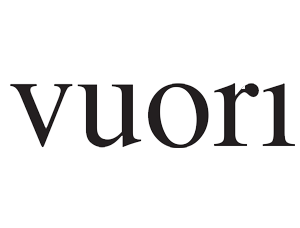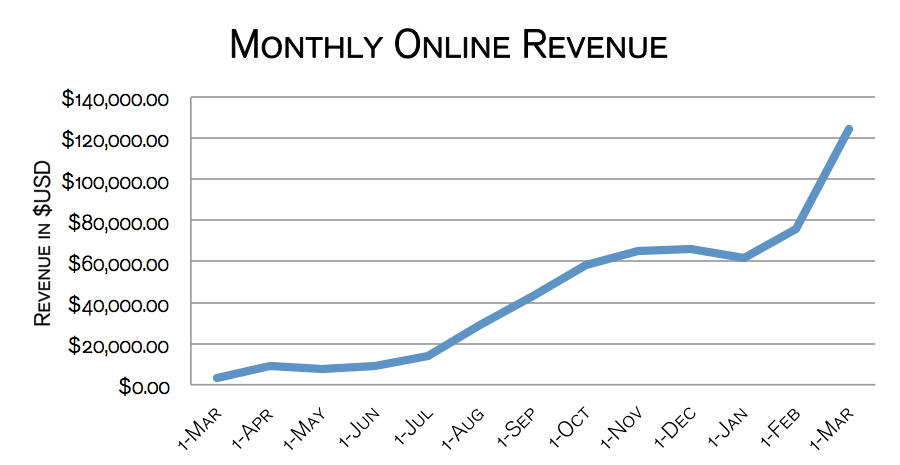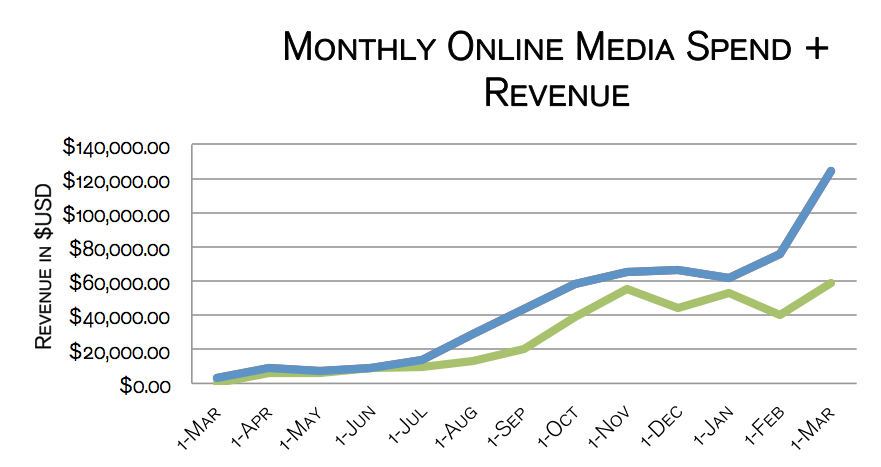(385) 449-1049

SmartClick was lucky enough to work with the founders of Vuori Clothing when it was just an idea, to lay the foundation for a brand that would become the most talked about brand in the athleisure category today, a brand now worth $4 billion according to Forbes Magazine. SmartClick was testing live ads on Facebook and Instagram to hone in on the brand positioning and tagline before product was even available. When product became available, Vuori officially launched and we were all amazed at the results. Of their partnership with SmartClick Joe Kudla, CEO/Founder of Vuori Clothing writes, "As a new company trying to understand how to define an e-commerce game plan, SmartClick was an incredible partner in guiding us through the process and executing a strategy that yielded a strong short term ROI while maintaining a strong focus on our long term goals.
We got to work. We focused in on the brand’s essence with great creative. We managed advertising campaigns to test targeting and minimize cost/conversion. We set realistic expectations based on seasonality and inventory levels. We weren’t afraid to recommend spending big on advertising. As a result, over a 9–month period we increased the brand’s monthly online revenue from less than $4,000 per
month to $125,000 per month, a run rate of over $1 million.
This chart showing revenue by month is:
Over the course of the year, the brand spent nothing on any other form of advertising—no print, no TV, no direct mail. They just used online marketing, managed by the team at SmartClick Advertising.
We learned that by following four key principles, we could create a million-dollar brand in less than a year:
A/B Test to develop the perfect creative
A key component of driving big sales for a start-up is developing a rigorous A/B testing regimen to test different combinations of copy and imagery. We didn’t test, as many agencies do, by simply looking at click-through rates; we actually tied ads to performance by measuring conversions—actual revenue. As a result, we were able to home in on ads that drove the most conversions for the brand at the lowest cost per conversion.
But before that, we actually began the creative testing process to get the brand right long before it even launched.
Back in the summer of 2014, the client had engaged us to begin seeding the market with interest about the brand. We pivoted that idea and pitched the client on the concept that we could use Facebook ad campaigns to gauge and test brand taglines, attributes and positioning.
Before product had even arrived to ship, we spent two months testing different combinations of imagery, copy, and targeting. Then, before the brand shipped a single item, we measured email captures as a conversion and were able to analyze conversion rates and cost/conversion to develop better and better ads in real time.
In fact, in over two months of testing before the brand launched, we developed dozens of great headlines/taglines, as well as two headlines/taglines that far outperformed the ones the client had developed. When the client saw the data, they weren’t wedded to their own idea—they were entirely willing to let the data lead us. By using conversion data to develop ads, we freed ourselves from having to be dependent on the whims of a client’s taste, instead making real, data-driven decisions to guide the creative process.
Knowing which ads performed the best in test allowed us to hit the ground running when product was finally available to ship. Even still, you may notice from the chart above that monthly online revenue was very modest in the initial 4 months of the campaign. That’s because of the trade-off between testing and maximizing short-term revenue. For that reason, it’s important to realize that, if you’re going to test, you’re not going to maximize short-term revenue. We were fortunate to have a client who was patient, saw the big picture, and trusted us to test before we even tried to scale.
Manage advertising campaigns to test targets and drive conversions
As we tested creative, we also tested multiple media types and different target audiences. We did this because the client clearly had no brand awareness to harvest, unlike an established brand (that has enough to merit capitalizing on branded keywords on paid search or creating big retargeting campaigns). First, our client’s brand needed awareness.
In this case we tested 3 main awareness building media vehicles:
The non-branded keywords on Google performed and continue to perform well, but the number of terms that drove significant volume at a low cost/conversion was limited. This is the main issue with Google in general and why I would not want to be one of its shareholders right now—there’s a limited supply of top performing ROI (return on investment)-driving keywords. AdWords just doesn’t scale. Even though we were able to eke out more volume with BingAds, there’s simply a finite amount of awareness you can drive profitably with paid search.
Display advertising for the brand was largely ineffective; it’s difficult to target as precisely as you would need to in order to match the performance of Google. With display, you can target a demographic and some interests, but it’s very limited. That, combined with the inherent issues with ad fraud on display, means that it’s a rare brand that can make efficient use of display.
Facebook-sponsored posts, however, are an entirely different story. With display, we could only buy men with an interest in yoga, since that’s who the brand was targeting. The reason Facebook performed so well for the brand was that we could actually test cells of men who liked hot yoga versus men who liked bikram yoga. Even better, we mastered the set up of lookalike audiences on Facebook. This means that we were able to take a mailing list of past customers and advertise to the closest 1–10% of Facebook profiles that were most similar to those of past purchasers. And while other suppliers have lookalike audience products, we haven’t found anyone else with a targeting product that works even close to as well as Facebook’s.
We were able to demonstrate that using Facebook to retarget past site visitors, past purchasers, and cart abandoners was an incredibly powerful tool when combined with awareness-building sponsored posts directed at lookalike or interest targets. For our particular Facebook retargeting campaigns, we used a little-known third party intermediary who had a recommendation engine that was far more sophisticated. It actually showed the consumer the exact product and related products that they viewed when on the website. While placing ads this way is slightly more expensive, we made up the increased cost/click at a far lower cost/conversion.
As a result, over the course of the year, over 90% of our ad spending for the brand was on Facebook, either in the form of awareness-driving targeted ads or retargeting ads. As we spent more on Facebook, revenue for the brand went up—even revenue that was not easily or directly attributable to Facebook.
Don’t be afraid to scale and spend big on advertising
Once you’re at a point where you’ve dialed in the most effective creative through A/B testing and when you’ve driven conversions efficiently at the lowest cost/conversion with media that is scalable, it’s time to think about scaling up.
It may seem elementary, but you’ve got to spend money to make money. In the case of this brand, they were willing to let us drive sales at a media spend rate of 2:1. In other words, if we could drive a little more than $2 in total brand online revenue for every $1 we spent in media, they would be happy. In this case, with a new brand, we could amortize the cost of new customers versus their lifetime value to the brand. We believed we could scale significantly at that rate of ROI.
Many clients can’t wrap their heads around the fact that when you increase spending on paid advertising it has a dramatic ripple effect on organic search and direct visits as well. Fortunately, this client did. In general, only a small percentage of the revenue we drive for clients from Facebook comes back as last click revenue from Facebook. However, when we apply sophisticated statistical modeling techniques and do a multiple linear regression analysis on different revenue versus spending by paid media type, we find that over 80% of all organic search and direct revenue were driven by paid advertising on Facebook.
As we looked at Facebook’s last click revenue numbers for this brand, we saw that the direct revenue coming from Facebook was underwhelming: for every $1 we put into Facebook we were only getting $1 out. However, in this case the client didn’t need a sophisticated statistical analysis to know that nothing else could be driving the big overall revenue numbers for the brand.
So we spent more, and more, and more each month between July and October.
The green line shows how we ramped up spending on media between July and October of last year and how revenue grew, almost in lockstep, with spending.
We were ecstatic to see all our hard work of A/B testing creative, testing multiple media types and target audiences, and the increased monthly media spend paying off, but we topped out at $65,000 in revenue in October—still short of our goal of a run rate of $1 million.
Set expectations based on inventory seasonality and inventory
The fact is that, after the huge, hard-won October revenue numbers, revenue stagnated for a time. A combination of decreasing seasonality (the brand has California beach/yoga positioning) and out-of-stocks meant that, no matter how much more we spent, we couldn’t increase revenue until the weather warmed up again in the spring and we addressed the inventory issues.
By February of this year, the brand was able to reorder and replenish their warehouse shelves with fresh product. It was also starting to warm up, and consumers were looking to buy shorts and tank tops again. At that point, we spent less than $40,000 and drove a new record of $80,000 in revenue.
By March, with full inventory and an early spring hitting many parts of the U.S., we blew away our goal with a spend of $58,000 driving $125,000 in revenue. We were all ecstatic—we’d reached a run rate of more than $1 million in less than 9 months.
Looking Back
It was quite a year for the brand. We hit our goal because we followed a process:
We were extraordinarily fortunate to have a client who was willing to trust the data, trust consumers, and trust us to deliver. We’ve already embarked with other similarly-minded new clients to build more young consumer brands. We’re excited to take on these next challenges.